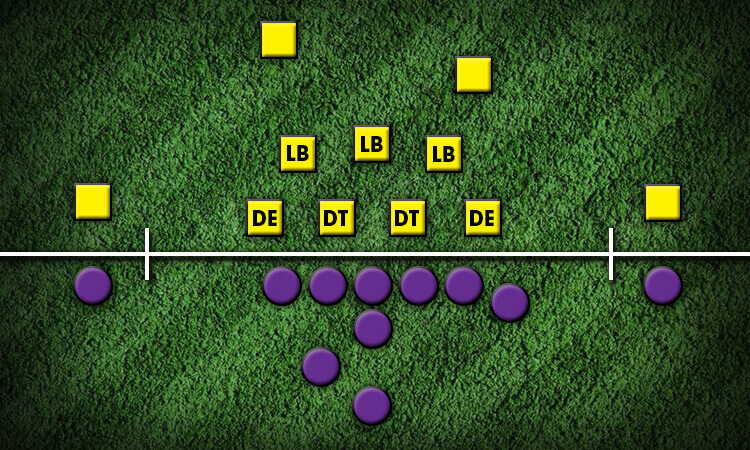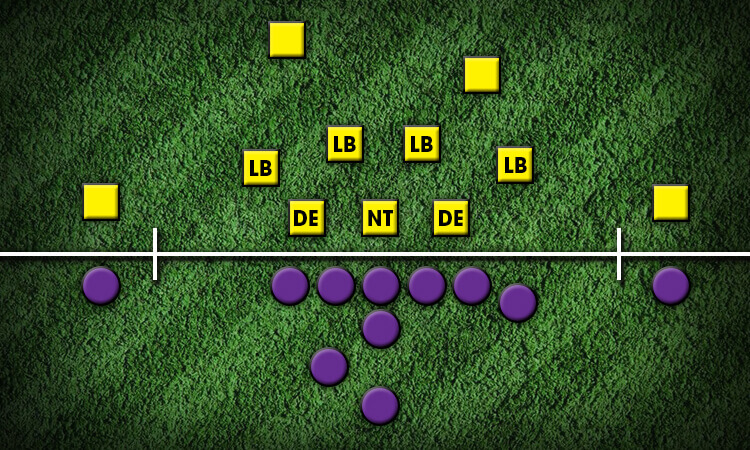
The 3-4 defense is one of the more interesting innovations in American Football, and one that the Pittsburgh Steelers used to great advantage for decades, not just in on-the-field performance, but in talent evaluation. With the NFL draft quickly approaching, let’s take a look at just how the 3-4 defense worked to Pittsburgh’s favor in terms of exploiting the existing market to unearth some exciting talent on defense.
A Breakdown of Defensive Setups in the NFL
First, it might be helpful to explain what the 3-4 defense is and how it works. In a typical base defense, which is also commonly referred to as a 4-3 defense, a team will deploy four defensive lineman and three linebackers in their front seven group of defenders. This is where the name 4-3 comes from. The defensive lineman play up front and play lower to the ground to get leverage against the opposing team’s offensive lineman, while the linebackers stand more upright to assume a greater range of responsibilities.
The 4-3 Defense

The primary goal for the four defensive lineman is to rush the quarterback and force a bad throw or sack him for a loss of yardage. A standard play call will have those four rushing; anything more than that is called a blitz, which augments the pass rush at the expense of coverage on receivers.
The 3-4 Defense

The 3-4 defense flips the line and linebackers, with three players playing up front and four linebackers standing upright behind them. The four-man rush remains in play as in a traditional defense, but the twist is that now any one of the four linebackers can act as that fourth pass rusher, which can confuse an opposing offense – a huge advantage over the course of a game.
The different style of defense leads to different type of talent requirements. The defensive line as a whole is larger in the 3-4 than in the 4-3. Outside linebackers in a 3-4 defense, who play on the edges of the front seven, are typically larger and less agile than their 4-3 counterparts.
Why This Swap Helped Win Games
While the 3-4 defense has waxed and waned in popularity since the 1980s, the Steelers are the only team to run it continuously since that decade. The advantage that this has given them as a result is that they’ve been able to snatch up valuable players in the draft and free agency that simply do not fit in a traditional 4-3 defense, such as college defensive ends who are too small to play that same position in the pros, but not quick enough to play linebacker in a 4-3. Because these players are in low demand league-wide, the Steelers are able to spend less valuable draft picks on them and sign them to cheaper initial contracts.
One of the best examples of the Steelers exploiting this gap in the market is James Harrison, who went undrafted and unnoticed until the Steelers plugged him into the lineup and let him flourish to the point where he won the NFL Defensive Player of the Year award in 2008. If the 3-4 defense was more in style at the time, Pittsburgh may have missed out on Harrison as demand drove up interest from other teams.https://www.instagram.com/p/BEMx8sBJFkx/embed/?cr=1&v=6&wp=658&rd=https%3A%2F%2Fwww.rushimprint.com&rp=%2Fblog%2F2016%2F04%2Fthe-3-4-defense-how-to-capitalize-on-a-gap-in-the-market%2F#%7B%22ci%22%3A0%2C%22os%22%3A964.5000007003546%7D
Luckily for Pittsburgh, they were one of the few NFL teams to run a true 3-4 defense at the time, and that strategy helped them exploit a market inefficiency to find low-demand and little-used talent that fit their team perfectly for a relative pittance.
What This Means for Your Business
By recognizing a gap in the market, and tailoring their strategy accordingly, the Pittsburgh Steelers were able to strengthen their efforts in ways other franchises couldn’t. Take a page from their playbook. By incorporating unorthodox strategies in creative ways, your business will set itself apart from the competition.
What has your business done to stand out from others in your industry? How did you go against convention? Was it a successful venture or did it fall flat on its face? Let us know in the comment section below!

